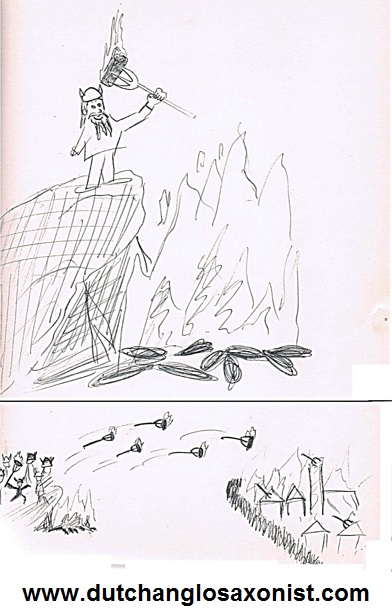Alfred and the cakes, Cnut and the waves, and Eadmer the flying monk: Anglo-Saxon history is full of anecdotes. On this blog I will regularly highlight some amusing and/or remarkable episodes from early medieval England, along with a selfmade cartoon. This post discusses the remarkable events leading up to and including the Battle of Fulford in 1066…
As one of the three major battles of the year 1066, the Battle of Fulford is often ignored in favour of the English victory over the Vikings at Stamford Bridge and the English loss against the Normans at Hastings. Yet, this battle that took place on 20 September 1066 deserves our attention as well, if only because a 13th-century, Icelandic source connects this event to several interesting Anglo-Saxon anecdotes. All these anecdotes are found in the Heimskringla, a series of sagas concerning the lives of Norwegian Kings, written by the great Icelandic poet-scholar Snorri Sturluson around the year 1230.
Prophetic dreams of witch-wives
Like William the Conqueror, the Norwegian king Harald Hardrada claimed the throne of England in the year 1066. Snorri reports that, before Harald’s fleet sets off for England, some Vikings had troublesome dreams. One of them was called Gyrd, who dreamed that he was:
standing in the king’s ship and saw a great witch-wife standing on the island, with a fork in one hand and a trough in the other. He thought also that he saw over all the fleet, and that a fowl was sitting upon every ship’s stern. (trans. Laing 1844)
Gyrd’s fork-bearing witch-wife also appeared in the nocturnal vision of another Viking, called Thord:
He dreamt that King Harald’s fleet came to England and he saw a big battle, and before the English army, a huge witch-wife was riding upon a wolf and the wolf had a man’s carcass in his mouth, and the blood was dropping from his jaws; and when he had eaten up one body she threw another into his mouth, and so one after another, and he swallowed them all. And she sang thus:
‘Skade’s eagle eyes
The king’s ill luck espies:
Though glancing shields
Hide the green fields,
The king’s ill luck she spies.
To bode the doom of this great king,
The flesh of bleeding men I fling
To hairy jaw and hungry maw!
To hairy jaw and hungry maw!’ (trans. Laing 1844)
In case you didn’t get that, the witch-wife predicts an ill fate for King Harald Hardrada (who, indeed, died at the Battle of Stamford Bridge, on the 25th of September, 1066).

Pelt them with pitchforks! How the Vikings burned Scarborough
Harald and his Viking army land in England in September, 1066, with some 300 ships and some 9,000 men. The first thing they did was sack Scarborough. Naturally, the town was protected by a town wall of some sorts, but Harald found a way around this, or, rather, over this. His brilliant tactic involved hurling fiery pitchforks:
[Harald] climbed up on to the rock that stands there, and had a huge pyre built on top of it and set alight; when the pyre was ablaze they used long pitchforks to hurl the burning faggots down into the town.

The Battle at Fulford and a bridge made of people
Later, on the 20th of September, 1066, Harald gloriously defeated an English army at Fulford led by the English earls Morcar and Edwin. The English army was put to flight and Harald Hardrada won the day. To make matters worse, some of the unfortunate English stumbled into a swamp, as Snorri reports:
The English army quickly broke into flight, some fleeing up the river, and others down the river; but most of them fled into the swamp, where the dead piled up so thickly that the Norwegians could cross the swamp dry-shod. (trans. Laing 1844)

Snorri’s Heimskringla, naturally, is not the most trustworthy of sources when it comes to the events of the year 1066; nevertheless, I hope that some of the re-enactments in celebration of this year’s 950-year-memorial will feature flying, fiery pitchforks, Vikings crossings swamps over bridges made of people and, who knows, fork-bearing witch-wives riding wolves!
If you liked this post, you may also enjoy:
- An Anglo-Saxon Anecdote: The Battle of the Birds, 671
- An Anglo-Saxon Anecdote: How beer and bees beat the Viking siege of Chester in c. 907
- An Anglo-Saxon Anecdote: Earl Siward and the Proper Ways to Die
- An Anglo-Saxon Anecdote: The Real Night of the Long Knives
- An Anglo-Saxon Anecdote: How Hengest was led by the nose
- An Anglo-Saxon Anecdote: Alleluia, the Anglo-Saxon Boo!
Stay tuned for more illustrated Anglo-Saxon anecdotes in the future!
Works referred to:
Laing, Samuel, trans. The Heimskringla. Or, Chronicles of the Kings of Norway (Vol. 3). London: Longman, Brown, Green and Longmans, 1844.

The battle of Fulford anniversary this day~Art work impressive~Cheers~
LikeLiked by 1 person
A great post. Many forget that there were 3 battles in 1066, probably because history is written by the ultimate winners. But, dare I suggest, the witch-wives in the illustrations look a little stereotypical?
LikeLiked by 1 person
A valid point, concerning the witch-wives – note that the Vikings also have the stereotypical (and historically inaccurate) horned helmets…
LikeLiked by 1 person
I wasn’t too worried about the helmets! But one of the things that interests me about Anglo-Saxon writings and, for example, the Orkneyinga (Sp?) Saga is that they don’t seem to trivialise or denigrate women and their doings.
LikeLike